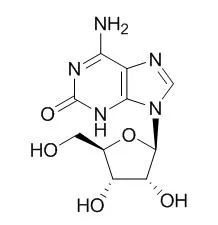| Structure Identification: |
| J Phys Chem A. 2013 Jul 18;117(28):5715-25. | | Mechanism of the deamination reaction of isoguanine: a theoretical investigation.[Pubmed: 23789717] |
METHODS AND RESULTS:
Mechanisms of the deamination reactions of isoguanine (Crotonoside) with H2O, OH(-), and OH(-)/H2O and of protonated isoguanine (isoGH(+)) with H2O have been investigated by theoretical calculations. Eight pathways, paths A-H, have been explored and the thermodynamic properties (ΔE, ΔH, and ΔG), activation energies, enthalpies, and Gibbs energies of activation were calculated for each reaction investigated. Compared with the deamination reaction of isoguanine or protonated isoguanine (isoGH(+)) with water, the deamination reaction of isoguanine with OH(-) shows a lower Gibbs energy of activation at the rate-determining step, indicating that the deamination reaction of isoguanine is favorably to take place for the deprotonated form isoG(-) with water.
CONCLUSIONS:
With the assistance of an extra water, the reaction of isoguanine with OH(-)/H2O, pathways F and H, are found to be the most feasible pathways in aqueous solution due to their lowest Gibbs energy of activation of 174.7 and 172.6 kJ mol(-1), respectively, at the B3LYP/6-311++G(d,p) level of theory. | | Biochemistry. 1994 Oct 11;33(40):12119-26. | | Isoguanosine substitution of conserved adenosines in the hammerhead ribozyme.[Pubmed: 7918433] |
METHODS AND RESULTS:
Isoguanosine(Crotonoside) has been incorporated into a 34-mer hammerhead ribozyme by the solid-phase phosphoramidite method, using an acetamidine base protecting group. The activity of the hammerhead ribozyme when singly mutated to isoguanosine at the adenosine positions 6, 9, and 13 was 1-2-fold less than the wild-type activity. Mutations to 2-aminopurine ribonucleoside at positions 9 and 13 were 5-fold reduced in activity, but that at position 6 was approximately 30-fold reduced.
CONCLUSIONS:
These results support the view that the 6-amino functions of A6, A9, and A13 are not very important for catalysis. The 2-position of A6 tolerates a carbonyl function but not an amino group, whereas A9 and A13 tolerate both functional groups. The tolerance of a 2-amino group at A9 and A13 makes G(anti)/A(anti) Watson-Crick type base mispairing for G12/A9 and A13/G8 unlikely. |
|






 Cell. 2018 Jan 11;172(1-2):249-261.e12. doi: 10.1016/j.cell.2017.12.019.IF=36.216(2019)
Cell. 2018 Jan 11;172(1-2):249-261.e12. doi: 10.1016/j.cell.2017.12.019.IF=36.216(2019) Cell Metab. 2020 Mar 3;31(3):534-548.e5. doi: 10.1016/j.cmet.2020.01.002.IF=22.415(2019)
Cell Metab. 2020 Mar 3;31(3):534-548.e5. doi: 10.1016/j.cmet.2020.01.002.IF=22.415(2019) Mol Cell. 2017 Nov 16;68(4):673-685.e6. doi: 10.1016/j.molcel.2017.10.022.IF=14.548(2019)
Mol Cell. 2017 Nov 16;68(4):673-685.e6. doi: 10.1016/j.molcel.2017.10.022.IF=14.548(2019)